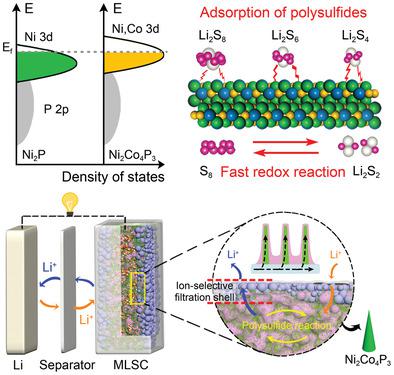当前位置:
X-MOL 学术
›
Adv. Funct. Mater.
›
论文详情
Our official English website, www.x-mol.net, welcomes your
feedback! (Note: you will need to create a separate account there.)
Efficient Ni2Co4P3 Nanowires Catalysts Enhance Ultrahigh‐Loading Lithium–Sulfur Conversion in a Microreactor‐Like Battery
Advanced Functional Materials ( IF 18.5 ) Pub Date : 2019-10-22 , DOI: 10.1002/adfm.201906661 Zihan Shen 1 , Mengqiu Cao 1 , Zili Zhang 1 , Jun Pu 1 , Chenglin Zhong 1 , Jiachen Li 2 , Haixia Ma 2 , Fujun Li 3 , Jia Zhu 1 , Feng Pan 4 , Huigang Zhang 1
Advanced Functional Materials ( IF 18.5 ) Pub Date : 2019-10-22 , DOI: 10.1002/adfm.201906661 Zihan Shen 1 , Mengqiu Cao 1 , Zili Zhang 1 , Jun Pu 1 , Chenglin Zhong 1 , Jiachen Li 2 , Haixia Ma 2 , Fujun Li 3 , Jia Zhu 1 , Feng Pan 4 , Huigang Zhang 1
Affiliation

|
High‐loading lithium–sulfur (Li–S) batteries suffer from poor electrochemical properties. Electrocatalysts can accelerate polysulfides conversion and suppress their migration to improve battery cyclability. However, catalysts for Li–S batteries usually lack a rational design. A d‐band tuning strategy is reported by alloying cobalt to metal sites of Ni2P to enhance the interaction between polysulfides and catalysts. A molecular or atomic level analysis reveals that Ni2Co4P3 is able to weaken the SS bonds and lower the activation energy of polysulfides conversion, which is confirmed with temperature‐dependent experiments. Ni2Co4P3 nanowires are further fabricated on a porous nickel scaffold to unfold the catalytic activity by its large surface area. Using a simple ion‐selective filtration shell, a microreactor‐like S cathode (MLSC) is constructed to realize ultrahigh S loading (25 mg cm−2). As such, a microreactor design integrates reaction and separation in one cell and can effectively address the polysulfide issues, the MLSC cell demonstrates excellent properties of cyclability and high capacity (1223 mAh g−1 at 0.1 C). More importantly, the catalyst's designs and microreactor strategies provide new approaches for addressing the complicated issues of Li–S batteries.
中文翻译:

高效的Ni2Co4P3纳米线催化剂可增强微反应器样电池中的超高负载锂硫转化率
高负荷锂硫(Li–S)电池的电化学性能较差。电催化剂可以加速多硫化物的转化并抑制其迁移,从而提高电池的循环能力。但是,用于Li-S电池的催化剂通常缺乏合理的设计。据报道,通过将钴与Ni 2 P的金属部位合金化来增强多硫化物与催化剂之间的相互作用,这是一种d波段调节策略。分子或原子能级分析表明,Ni 2 Co 4 P 3能够弱化SS键并降低多硫化物转化的活化能,这一点已通过温度依赖性实验得到了证实。Ni 2 Co 4 P 3在多孔镍支架上进一步制造纳米线,以通过其大表面积展现催化活性。使用简单的离子选择滤壳,可构建类似微反应器的S阴极(MLSC),以实现超高的S负载(25 mg cm -2)。这样,微反应器设计将反应和分离整合到一个单元中,并且可以有效解决多硫化物问题,MLSC单元显示出出色的循环性能和高容量(在0.1 C下为1223 mAh g -1)。更重要的是,催化剂的设计和微反应器策略提供了解决Li-S电池复杂问题的新方法。
更新日期:2020-01-17
中文翻译:

高效的Ni2Co4P3纳米线催化剂可增强微反应器样电池中的超高负载锂硫转化率
高负荷锂硫(Li–S)电池的电化学性能较差。电催化剂可以加速多硫化物的转化并抑制其迁移,从而提高电池的循环能力。但是,用于Li-S电池的催化剂通常缺乏合理的设计。据报道,通过将钴与Ni 2 P的金属部位合金化来增强多硫化物与催化剂之间的相互作用,这是一种d波段调节策略。分子或原子能级分析表明,Ni 2 Co 4 P 3能够弱化SS键并降低多硫化物转化的活化能,这一点已通过温度依赖性实验得到了证实。Ni 2 Co 4 P 3在多孔镍支架上进一步制造纳米线,以通过其大表面积展现催化活性。使用简单的离子选择滤壳,可构建类似微反应器的S阴极(MLSC),以实现超高的S负载(25 mg cm -2)。这样,微反应器设计将反应和分离整合到一个单元中,并且可以有效解决多硫化物问题,MLSC单元显示出出色的循环性能和高容量(在0.1 C下为1223 mAh g -1)。更重要的是,催化剂的设计和微反应器策略提供了解决Li-S电池复杂问题的新方法。











































 京公网安备 11010802027423号
京公网安备 11010802027423号